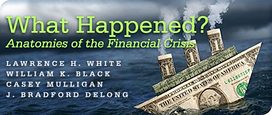In response to my observation that he had put little emphasis on the real estate and other malinvestments that kicked off our financial turmoil, Bradford DeLong writes:
That there are “malinvestments… wealth-squandering mistakes” … is simply not news.
I understand that Professor DeLong’s main interest lies elsewhere, in the question of what has made the global decline in measured financial wealth so much larger than in earlier crises. Nevertheless — news or not — I think the opening phase of the crisis calls for explanation.
DeLong caricatures my account as follows:
White’s theory seems to be that our current crisis is deserved and inevitable retribution for financial fecklessness. … White’s position is, I think, a normal reaction derived from monkey psychology — the band of monkeys hangs together better if monkeys fear that they will be punished if they transgress the rules. But I don’t think it helps us understand what is going on very much.
In fact, I think economic reasoning about cause and effect (not monkey psychology) helps us to understand what is going on. Economic reasoning does not require the use of, nor have I used, normatively loaded terms like “deserved” or “retribution” or “fecklessness.” To repeat what I wrote on my blog in September:
This isn’t a morality play. What we’re seeing are the consequences of monetary-policy distortions of interest rates and regulatory distortions of incentives, amplified in some degree by private imprudence, not the consequences of blackheartedness.
Nor, I would add, need we appeal to “fecklessness,” if that implies some additional moral failing beyond imprudence and miscalculation.
I myself don’t think that Professor DeLong’s “utilitarian’s dream” helps us to understand what is going on very much. This appears to be a normative yardstick according to which there would be more risk-spreading, more intermediation, and more investment in an ideal world (of zero transactions costs, complete markets, and perfect information?) than in our real world. By such a standard, “financial markets do not do a good job.” Here we seem to have a variety of what Harold Demsetz used to call the “Nirvana fallacy.” The real never measures up to the imaginary ideal.
DeLong concludes that there isn’t a lot of sense in talking about “overinvestment” in the real-world economy, apparently because the ideal world would always have more investment than we have even at the peak of an investment boom. In my view, by contrast, it is perfectly sensible and useful to talk about whether investment in the real-world economy has been expanded beyond voluntary saving in the real-world economy. It is sensible and useful to talk about whether investment was misallocated, in particular whether real-estate investment was unsustainably large.
Professor DeLong writes that “the proper public policy response to every situation that White would characterize as one of ‘overinvestment’ is, I think, one in which the government takes steps to mobilize more of society’s risk-bearing capacity rather than letting asset prices collapse and create massive unemployment.” But does any decline in asset prices from their level at the peak of the boom constitute a “collapse”? Does DeLong believe that it is never proper policy to let unsustainably high asset prices return to equilibrium, and to let misemployed capital goods and labor be reallocated to better uses, provided that we take care to avoid a collapse in nominal aggregate demand and thereby the deep depression and massive unemployment that nobody wants?

